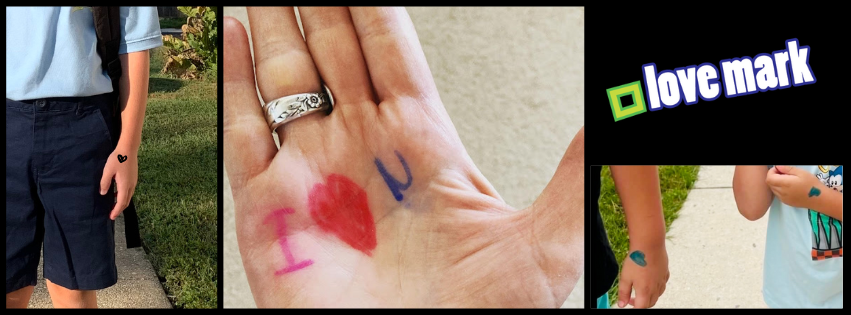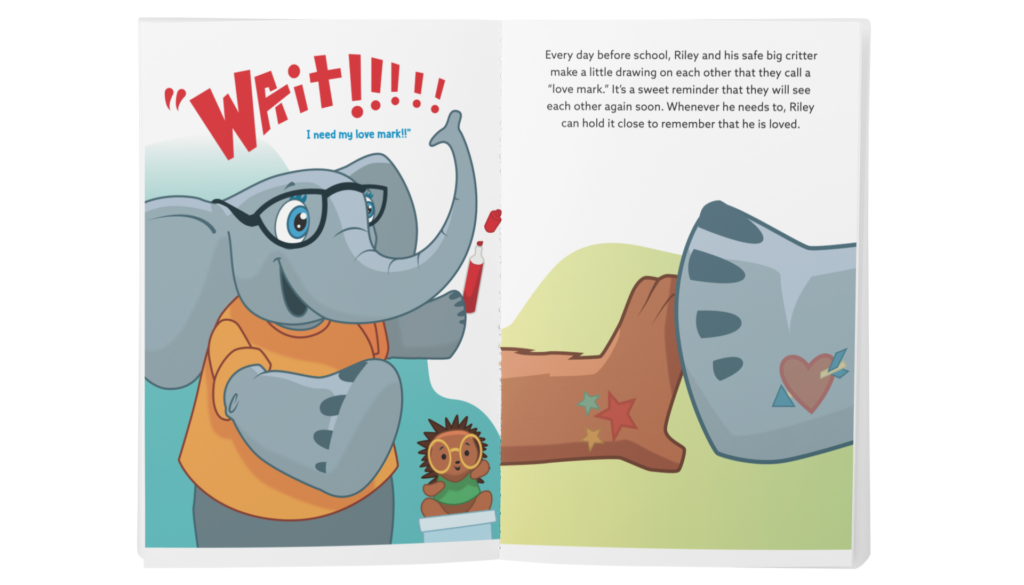A Back-to-School Guide for Parents and Therapists
As I write this, the back-to-school season is in full swing here in the U.S., bringing a hearty mix of emotions to the surface for everyone involved. Whether you find yourself excited each fall or overwhelmed or nostalgic or anxious or all of the above, this blog post will provide some practical and playful ways to help kids navigate big feelings.
Why do kids (& adults) struggle with change?
I’m writing this as a child therapist and brain science enthusiast, but also as a mom of neurodiverse kids who sometimes struggle with change.
So while I know that the brain is alert to new experiences, often interpreting “unfamiliar” as “DANGER,” I also know how draining it can be to navigate the tears and meltdowns that go with the ebb and flow of family life.
Many kids struggle during the daily drop-off at school, the handoff to a babysitter or grandparent, or the afternoon pick-up. Children’s natural need for security and developing sense of self contribute to the stress and anxiety they feel during these daily transitions.
Cue tears and tantrums.
Transitions are often even more challenging for children who have experienced a loss.
The death of a loved one, the uncertainty of foster care, or even a more common experience like moving to a new home can be very dysregulating for kids.
When my young family moved from New York City to Wilmington, Delaware, one of my boys really struggled. Bedtime was a mess. Morning drop-off took forever. And when it was time for his beloved auntie to head back to NYC, the tears would sometimes last an hour (his and mine!).

I was working in the world of foster care and adoption at the time, and this experience was a poignant reminder of how difficult goodbyes can be even when you are still surrounded by people you love.
All that to say…
Change is hard on the brain.
And big life changes can make the little, everyday changes even more of a trigger for big feelings (and the big behavior that so often goes with).
Having navigated a lot of big life changes myself and with my therapy clients over the years, here are a few playful, practical ideas to help your kiddos through.
4 Creative Strategies to Smooth Out Rough Transitions
1. “Holding Kisses”
This was a favorite for one of my boys. “Holding Kisses” is a playful strategy that physically transfers a parent’s affection to the child in a tangible way. Here’s how it works:
- Start by showering your child’s hands with lots of kisses.
- Then, have your child place their hand on their belly or another easily accessible spot on their body.
- You can even add a fun countdown, like “5, 4, 3, 2, 1, and now your kisses are all tucked in!” to help cement the connection.
This technique serves several important purposes:
- Provides physical comfort: The sensation of your kisses “stored” in their body can be a soothing reminder of your presence, even when you’re apart.
- Builds emotional security: The ritual of “holding kisses” helps your child feel loved and cared for, especially if it happens day after day.
- Engages the senses: The combination of touch, sight, and sound (from the countdown and your playful tone of voice) can be calming and grounding.
While “Holding Kisses” doesn’t guarantee tear-free transitions, it can provide a much-needed boost to your child’s daily routine. Try it before school drop-offs, daycare arrivals, or other separation scenarios.
2. Sensory-Rich Transitions
Another effective approach is to incorporate sensory-rich activities into your child’s transitions. This could involve using their sense of touch, sound, or the hidden senses to help them feel more grounded and regulated.
For example, you could try:
- Hopping like a kangaroo or skipping to the door: Encouraging your child to move in a playful, energetic way as they enter a new environment can help them release pent-up energy and transition more smoothly.
- Squishes and squeezes: Providing deep pressure input, such as a firm hug or a few squeezes on their arms or shoulders, can help your child feel calmer and more centered. I share an example in this 30-second clip.
- Counting together or singing: Incorporate a simple counting or singing routine to create a familiar, predictable pattern during the transition.
The key is to find sensory-based activities that align with your child’s unique needs and preferences. Some children may thrive on more active, energetic transitions, while others need to move more slowly and methodically. Experiment to see what works best for your little one.
3. Create a Comfort Item
A small, familiar object can provide comfort during the school day. This could be a keychain, a stretchy beaded bracelet, a small stuffed animal, or even a little note from home. Having something tangible to hold onto can provide a sense of security while apart.
4. The Love Mark
One of my favorite techniques is the “Love Mark.” I have used it with so many families over the years! In fact, some moms I know now have tattoos of the love marks they shared day after day with their anxious kiddos.

Here’s how it works:
- Choose a marker or two: Too many options will increase the overwhelm and distract from the sweetness and steadying that this activity provides.
- Invite your child to draw a small symbol or shape on your skin: Ideas include a heart, star, smily face, or the first initial of their name.
- Then, you do the same for them: Create a matching “love mark” on your child in a spot that’s easily visible to them throughout the day, like on their wrist.
The love mark serves as a visual reminder of your connection even when you’re physically apart. Whenever your child sees their mark, or you see yours, there’s a little spark of comfort and security. This simple ritual can be a powerful tool for easing separation anxiety and helping your child feel more grounded during transitions.
And don’t be afraid to adapt it to suit your child’s preferences and developmental stage. Older kids may enjoy the collaborative aspect of creating the marks together, while younger children may prefer that you take the lead. Experiment to find what works best for your family.
For a playful way to introduce the love mark plus lots of other support for tough transitions, check out Riley the Brave Makes it to School.
Practice Makes Perfect Better
Each of the strategies described above can be incredibly helpful in the moment, but it’s important to consider how you can weave these ideas into everyday life. Here are a few suggestions…
Establish Predictable Routines
The brain loves predictability! Here are some other ways to help your child feel more in control and secure:
- Implement a predictable ritual at drop-off, such as one of the options described above.
- Incorporate a familiar activity or song during the transition (i.e. singing a goodbye song or getting 5 big squeezes and then mom bounces out of the room)
- Provide a visual schedule or countdown to help your child anticipate what’s coming next
These moments of predictability with a trusted adult help kids build foundational skills to handle the unpredictability the world will throw at them.
One often-overlooked element of preparing for the new school year is establishing a healthy sleep routine. Start by gradually adjusting bedtime a few minutes earlier each night, at least a week before school starts.
Sleep is crucial for brain function. It allows the brain to clean up, organize, and remember new information. Ensuring that everyone in the household gets enough rest can significantly ease the transition back to school. If sleep is an ongoing struggle for you or your child, talk with your doctor or mental health provider.
Practice Playfully
Another helpful idea I have used both as a mom and a therapist is to practice transition scenarios at home, in a low-stakes environment. For example:
- Role-play goodbyes and reunions with your child’s favorite stuffed animals or dolls.
- Incorporate transition-themed books or stories into your child’s regular reading time.
- Practice “holding kisses” or creating “love marks” with a stuffed animal or favorite toy when it’s time to clean up for the night.
By normalizing and rehearsing these transition experiences playfully in safe, familiar settings, you’re helping your child build the skills and confidence they need to navigate change in the real world.
Be a Team
Whenever possible, work closely with the other important adults in your child’s life – teachers, daycare providers, grandparents, etc. – to ensure a consistent, coordinated approach to transitions.
By working together as a team, you can create a more supportive environment for your child, no matter where they are or who they’re with.
Be Kind to Yourself Along the Way.
Savor Moments of Relaxation. Take a few long deep breaths, laugh with a friend instead of scrolling on social media, or step outside for a few minutes to recharge.
These intentional moments can make a big difference in your overall well-being.
Bring compassion to the inevitable meltdowns—theirs and yours. It’s predictable, but that doesn’t make it fun.
You are allowed to have feelings too! Plan coffee with a friend, go for a walk with your partner, or get in an extra-long workout to release some of that emotional energy.
We weren’t meant to do this parenting thing alone. Let’s normalize reaching out for help!
Change Is Hard, But It Also Creates Opportunities for Growth
While transitions can be challenging, they also present valuable opportunities for kids to develop essential life skills. My son still doesn’t love change, but saying goodbye to his auntie is no longer a devastating event. He doesn’t need a love mark anymore, but he still benefits from sensory supports during times of stress.
Remember, every child is unique, so be patient as you find the techniques that work best for your family or the various families you serve.
Your efforts in these small moments matter.
